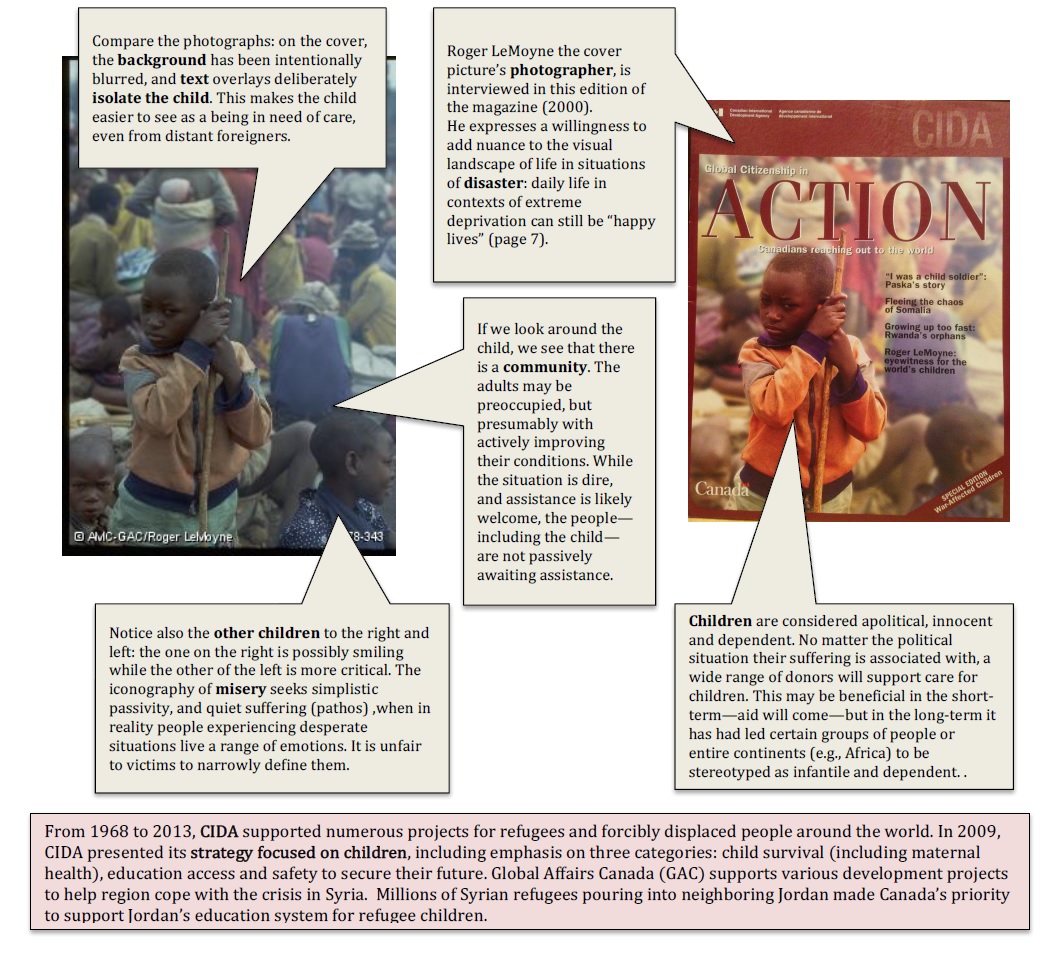Deadline: June 30, 2017.
Printer Friendly Call for Photographs.
Photographers and aid agencies each frame photographs according to their own politics, experiences and goals. These, in turn, shape spectators’ interpretations of people’s lived realities around the globe, and contribute to formulating responses to humanitarian issues. How have photographers and agencies represented refugees? How have refugees been pictured? In what way does the photographic version change when it has been published?
See how “Refugees on the road between Gisenyi and Ruhengeri,” a photograph of a Rwandan child made by Canadian photographer Roger LeMoyne’s in 1996 for the CIDA International Development Photo Library and published in 2000, can help answer these questions.
Pictures of refugees and displaced persons have been crucial to the successes and failures of campaigns of modern humanitarian aid. They set the tone of global relations, emphasizing solidarity, inequality, prejudice or justice. Why do images attract public attention? Have they changed? Have the ethics, sensitivity, capacity for outrage and sympathy evolved? Have the methods of photographers changed? How have NGOs navigated the pitfalls of the “limits of empathy and the pornography of suffering”? Is the public more critical? cynical? fatigued?
Collaborative collection, interpretations and diffusion: In the coming months, the historians, archivists, humanitarian worker members of the Canadian Network of Humanitarian History (CNHH) will collect and help present a dozen important pictures of Canadian development and humanitarian aid in a virtual exhibition to attempt to answer these questions. This collaboration will give the story behind the pictures, show the many ways by which a single image was used in the media, speak to the outcomes of the campaigns, give clues to viewers about how to read pictures, and explore differences in reading pictures over time. A final virtual exhibit will be open access, posted on the websites of contributors and of the CNHH.
Interested in contributing? You are invited to participate by sharing a picture or visual story from your organization that could contribute to a history of visual representations of Canadian aid provided to people forcibly displaced by conflict, disaster or emergencies. Please contact us in the coming months. We look forward to seeing how we can work with you in identifying photographs that have histories and invaluable insights for sharing in this virtual exhibit.
See the example: The image featured on the other side of this page was taken for the Canadian International Development Agency photo library in 1996 by Canadian photographer Roger LeMoyne. Comments on the picture and publication give an idea of the project.
In the long term: Today, one generation after the exponential growth of aid and modern humanitarianism, it is urgent to identify and preserve archives and testimonies. Histories of these interventions abroad is invaluable for the study of the cultural, economic, political and social implications of the movement of people, and for informing consideration for future interventions. The CNHH invites you to be part of the preservation pictures of humanitarianism. The project will be of special interest to NGOs celebrating milestone anniversaries and looking for ways to take stock of, and share, their institutional memories, inventories of best practices, and ensure their financial and institutional future by attracting donations from older generations. One specific arm of this project, in collaboration with Carleton University’s Disability Research Group, is particularly interested in stories related to disability and technology. The project is financed by a Migration & Diaspora Studies TD grant.
Contact us: Dominique Marshall, dominique_marshall@carleton.ca
Sonya de Laat, RA, Refugee & Forged Migration project, delaat@mcmaster.ca
Beth Robertson, RA, Disability Research Group, bethrobertson@cmail.carleton.ca





As Prof Marshall is aware I have an extensive collection of refugee photographs taken during the 1980’s in Honduras. Refugees from Salvador lived in several camps-ultimately in two major camps. I visited quite frequently occasionally alone but most often with small missions of Canadian politicians, trade unionists, lawyers, artists. My collection is housed in archives at Carleton University in the form of slides and prints but I have many digitized photos on my computer which can be easily transmitted. My problem in responding is how many photos you would like to have. There are pictures of children and adults, victims of attacks on the camps by the military, groups, camp production activities,etc. If you can define what would be of interest I am sure I can accommodate you. I can include brief comments with each picture.